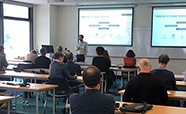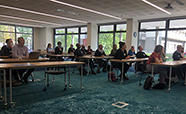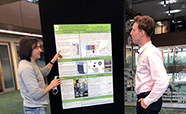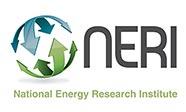18–19 November 2021, Room 1.17 Otago Business School, University of Otago campus, Dunedin
The theme for the 2021 symposium was “The Challenge of Net Zero by 2050”. Achieving Net Zero by 2050 will require a rapid transition to a decarbonised energy system and will affect every aspect of society. This monumental systemic change presents significant challenges across a range of different areas.
This symposium brought together diverse perspectives on these challenges (and possible opportunities), and we welcomed contributions from across the energy research community.
There were two focused sessions:
Day 1 – National Energy Modelling, co‑organised with NERI
Programme and abstract booklet
2021 OERC Symposium programme (PDF)
2021 OERC Symposium abstracts booklet (PDF)
Image gallery



View photos from the symposium on Flickr
Student prizes
 Kindly sponsored by the Energy Efficiency & Conservation Authority (EECA).
Kindly sponsored by the Energy Efficiency & Conservation Authority (EECA).
Best student presentation winner
Kirill Misiiuk
Spontaneous droplet motion on micropatterned aluminium for improved efficiency of heat-exchangers and wind turbines (PDF)
Runner-up student presentation winner
Aleida Powell
Modelling the Long-term Impacts of Increased Demand Response within a 100% Renewable New Zealand Power System (PDF)
Keynote presentation
Dr Stéphanie Bouckaert was unable to giver her presentation due to unforeseen circumstances. Thomas Spencer, who is one of the lead authors of the NZE report and of the WEO2021 (in particular of the Chapter 3, focusing on the NZE scenario), gave the keynote presentation.
- Thomas Spencer, Energy Modelling Office, International Energy Agency (IEA)
World Energy Outlook 2021 (PDF)
Presentations
Day 1: National Energy Modelling – co‑organised with NERI

- Dr Gareth Gretton
NZ energy scenarios: TIMES-NZ, EECA (PDF) - Dr Ian Mason
Energy Systems modelling for a Challenging Climate - Mr Greg Sise
Price formation and investment in a 100% Renewable Electricity Market (PDF) - Dr Jen Purdie
“100% renewable 2030 or 2040? – the implications” - Dr Jonathan Leaver
System Dynamics Integrated Assessment Modelling with UniSyD (PDF) - Aleida Powell
Modelling the Long-term Impacts of Increased Demand Response within a 100% Renewable New Zealand Power System (PDF) - Carsten Dortans
What happens to demand after households adopt PV? (PDF) - Kirill Misiiuk
Spontaneous droplet motion on micropatterned aluminium for improved efficiency of heat-exchangers and wind turbines (PDF) - Isabella Primentel Pincelli
Considering Material Cycles for a Transition to Low-Carbon Energy Systems in Aotearoa – New Zealand: a Systematic Review (PDF) - Solis Norton
EROI analysis of net zero transition modelling for New Zealand (PDF) - Tsani Rakhmah
Firm-Level Barriers to Geothermal Power Project Development in New Zealand (PDF)
Day 2: Energy Hardship and the Transition – co‑organised with the Consortium of Energy Hardship Evaluation (EECA)

- Ben Anderson
Simulating the consequences of a residential emissions based carbon levy at the city and neighbourhood scale (PDF) - Jake Cherrie
“Understanding energy efficiency benefits of insulation and heat pump retrofits using smart meter data” - Caroline Fyfe
From Hearth to Health: An investigation into the health impacts of the Warm Up New Zealand home insulation subsidy programme (PDF) - Ella Priest-Forsyth, Mel Pande, Victoria Coad, Laurie Boyce, Sym Pandey
Ministry of Business, Innovation and Employment's Energy Wellbeing Work Programme, MBIE (PDF) - Chris Mardon and Tracey Lyall
"King Country Energy Hardship Reducing Pilot Programme" - Leana Hunt and Susanna Barthow
'Healthy Homes Interventions' including 'Winter Warmer Packs' (PDF) - Jennifer van der Merwe
Kāinga Ora Emissions Reduction and Renewable Energy Programmes (PDF)
Quick-fire round on Energy Hardship and the Transition
- Mr Greg Overton
Transition to zero-carbon built environment – BRANZ – HEEP2 – opportunities and challenges from a national survey of household energy use (PDF) - Caroline Fyfe
Housing research: Transition to zero-carbon built environment – HEEP2 (PDF) - Scott Willis
Energy hardship, decarbonisation, and flax-roots innovation (PDF) - Smrithi Talwar
Community Resilience and Energy Security Research at GNS Science (PDF) - Anaru Waa
A framework for understanding how to promote wellness among Māori (PDF) - Miranda Struthers
Tackling energy hardship – an industry perspective (PDF) - Ryan Roberts
Aotearoa Community Renewable Energy: Design of an Impact Framework (PDF) - Gareth Cartwright
Maximising the Impact of Our Work (PDF)
Poster presentations
- Ngaio Fulton
Night-time Photovoltaics: An answer to the renewable energy supply-demand mismatch? (PDF) - Sam Lowrey
“Refrigerative Dehumidifier Performance Improvements using a 3D-Printed Polymer Energy Recovery Heat Exchanger” - Michael Bennington
A copper electrocatalyst for H2 production from a neutral water solution (PDF) - Chris Hughes
Condensation-frosting investigation on coating-free topographic wetting gradients for heat transfer surface applications (PDF) - Milan Chapagain
“Wetting Phenomena on 3D-Printed Heat Exchanger Surface”